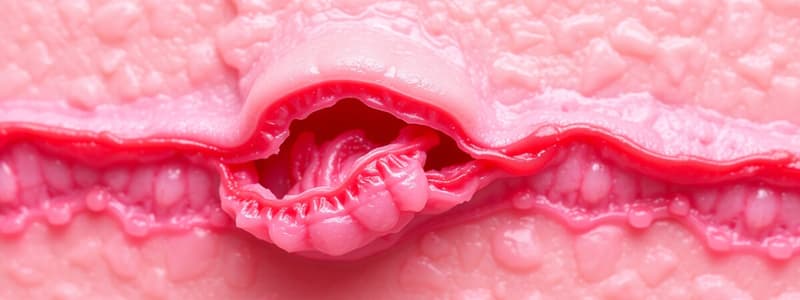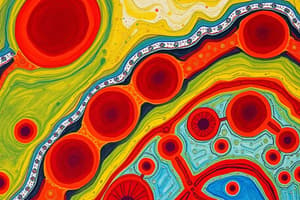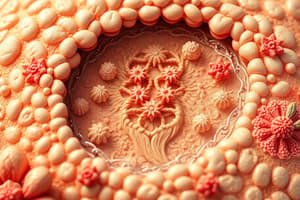Podcast
Questions and Answers
What is the primary function of the epidermal barrier?
What is the primary function of the epidermal barrier?
- Absorb nutrients from the environment
- Limit bacterial growth
- Regulate body temperature
- Prevent water loss and microbial infection (correct)
Which layer of the epidermis is primarily responsible for water loss?
Which layer of the epidermis is primarily responsible for water loss?
- Stratum Granulosum
- Stratum Basale
- Stratum Corneum (correct)
- Stratum Spinosum
What are melanosomes?
What are melanosomes?
- Granules containing melanin (correct)
- Protein structures in keratinocytes
- Cells that fight infections
- Components that form the epidermal barrier
What is the rate of transepidermal water loss (TEWL) in normal conditions?
What is the rate of transepidermal water loss (TEWL) in normal conditions?
Which type of cells predominantly make up the epidermis?
Which type of cells predominantly make up the epidermis?
Which epidermal layer is also known as the 'prickle layer'?
Which epidermal layer is also known as the 'prickle layer'?
What is the role of Langerhans cells in the epidermis?
What is the role of Langerhans cells in the epidermis?
Which skin layer is primarily involved in connecting the skin to underlying structures?
Which skin layer is primarily involved in connecting the skin to underlying structures?
What is the primary role of Langerhans' cells in the skin?
What is the primary role of Langerhans' cells in the skin?
What triggers the sensitization process in contact allergy?
What triggers the sensitization process in contact allergy?
What is a common source of allergic reactions to cosmetic products?
What is a common source of allergic reactions to cosmetic products?
Where do Langerhans' cells migrate after recognizing a hapten-protein complex?
Where do Langerhans' cells migrate after recognizing a hapten-protein complex?
What are keratinocytes primarily responsible for?
What are keratinocytes primarily responsible for?
What is the primary function of patch testing in contact allergies?
What is the primary function of patch testing in contact allergies?
Which of the following statements about contact dermatitis is true?
Which of the following statements about contact dermatitis is true?
What do stem cells in the epidermis predominantly produce?
What do stem cells in the epidermis predominantly produce?
What is the process called when daughter cells mature and move to the top of the epidermis?
What is the process called when daughter cells mature and move to the top of the epidermis?
What is the average normal cell cycle duration in the epidermis?
What is the average normal cell cycle duration in the epidermis?
What type of cells are found in psoriatic plaques that should not exist in the stratum corneum?
What type of cells are found in psoriatic plaques that should not exist in the stratum corneum?
What primarily characterizes the basal layer of the epidermis?
What primarily characterizes the basal layer of the epidermis?
Which layer of the epidermis contains keratohyalin granules?
Which layer of the epidermis contains keratohyalin granules?
What happens to keratinocytes as they transition to corneocytes in the granular layer?
What happens to keratinocytes as they transition to corneocytes in the granular layer?
Which of the following statements about desquamation is correct?
Which of the following statements about desquamation is correct?
What is the role of lamellar bodies in the granular layer of the epidermis?
What is the role of lamellar bodies in the granular layer of the epidermis?
What is the role of Natural Moisturizing Factor (NMF) in skin hydration?
What is the role of Natural Moisturizing Factor (NMF) in skin hydration?
Which of the following components are part of NMF?
Which of the following components are part of NMF?
How does aging affect the levels of NMF in the skin?
How does aging affect the levels of NMF in the skin?
What primary cell type is responsible for collagen production in the dermis?
What primary cell type is responsible for collagen production in the dermis?
What happens to the thickness of the dermis during childhood?
What happens to the thickness of the dermis during childhood?
Ichthyosis vulgaris is primarily caused by a defect in which of the following?
Ichthyosis vulgaris is primarily caused by a defect in which of the following?
What effect does washing skin with soap have on NMF levels?
What effect does washing skin with soap have on NMF levels?
What is a significant component of the dermis that contributes to its structure?
What is a significant component of the dermis that contributes to its structure?
What is the primary function of the stratum corneum in the skin?
What is the primary function of the stratum corneum in the skin?
Which structure primarily consists of keratin filaments and is present in the stratum corneum?
Which structure primarily consists of keratin filaments and is present in the stratum corneum?
What role do lipids play in the stratum corneum?
What role do lipids play in the stratum corneum?
What happens to desmosomes during desquamation in the upper stratum corneum?
What happens to desmosomes during desquamation in the upper stratum corneum?
The acidic pH of the stratum corneum is mainly due to the breakdown of which substance?
The acidic pH of the stratum corneum is mainly due to the breakdown of which substance?
Which layer of the epidermis is characterized by the presence of multiple lipid layers between squames?
Which layer of the epidermis is characterized by the presence of multiple lipid layers between squames?
What component is NOT found in the stratum corneum?
What component is NOT found in the stratum corneum?
Which cell type is transformed into corneocytes at the SG/SC interface?
Which cell type is transformed into corneocytes at the SG/SC interface?
What are desmosomes primarily responsible for in the stratum corneum?
What are desmosomes primarily responsible for in the stratum corneum?
What is the average thickness of the stratum corneum in the face?
What is the average thickness of the stratum corneum in the face?
What is one of the main functions of collagen in the dermis?
What is one of the main functions of collagen in the dermis?
Which type of collagen fibers are primarily found in the reticular dermis?
Which type of collagen fibers are primarily found in the reticular dermis?
What is the role of glycosaminoglycans (GAGs) in the dermis?
What is the role of glycosaminoglycans (GAGs) in the dermis?
What is a significant consequence of elastin degradation from sun exposure?
What is a significant consequence of elastin degradation from sun exposure?
What forms the dermal-epidermal junction (DEJ)?
What forms the dermal-epidermal junction (DEJ)?
How does the content of glycosaminoglycans change with aging?
How does the content of glycosaminoglycans change with aging?
Which of the following describes papillary dermis?
Which of the following describes papillary dermis?
Which nutrient is required for the synthesis of hydroxyproline and hydroxylysine?
Which nutrient is required for the synthesis of hydroxyproline and hydroxylysine?
Flashcards
Epidermis
Epidermis
The outermost layer of the skin, responsible for protecting the body from external factors.
Transepidermal Water Loss (TEWL)
Transepidermal Water Loss (TEWL)
The process of water loss from the body through the skin, primarily as water vapor.
Stratum Basale
Stratum Basale
The innermost layer of the epidermis, where new skin cells are generated.
Stratum Spinosum
Stratum Spinosum
Signup and view all the flashcards
Stratum Granulosum
Stratum Granulosum
Signup and view all the flashcards
Stratum Lucidum
Stratum Lucidum
Signup and view all the flashcards
Stratum Corneum
Stratum Corneum
Signup and view all the flashcards
Keratinocytes
Keratinocytes
Signup and view all the flashcards
Keratinization
Keratinization
Signup and view all the flashcards
Cell cycle of the epidermis
Cell cycle of the epidermis
Signup and view all the flashcards
Desquamation
Desquamation
Signup and view all the flashcards
Hyperproliferative hyperkeratosis
Hyperproliferative hyperkeratosis
Signup and view all the flashcards
Psoriasis
Psoriasis
Signup and view all the flashcards
Parakeratotic cells
Parakeratotic cells
Signup and view all the flashcards
Basal layer
Basal layer
Signup and view all the flashcards
Spinous layer
Spinous layer
Signup and view all the flashcards
What are antigens?
What are antigens?
Signup and view all the flashcards
What are antigen-presenting cells (APCs)?
What are antigen-presenting cells (APCs)?
Signup and view all the flashcards
What are Langerhans cells?
What are Langerhans cells?
Signup and view all the flashcards
What is the Finn chamber?
What is the Finn chamber?
Signup and view all the flashcards
What is contact sensitization?
What is contact sensitization?
Signup and view all the flashcards
What is patch testing?
What is patch testing?
Signup and view all the flashcards
What does a positive reaction in a patch test mean?
What does a positive reaction in a patch test mean?
Signup and view all the flashcards
What are the most common allergens in cosmetic products?
What are the most common allergens in cosmetic products?
Signup and view all the flashcards
Natural Moisturizing Factor (NMF)
Natural Moisturizing Factor (NMF)
Signup and view all the flashcards
Ichthyosis Vulgaris
Ichthyosis Vulgaris
Signup and view all the flashcards
Collagen
Collagen
Signup and view all the flashcards
Fibroblasts
Fibroblasts
Signup and view all the flashcards
Elastin
Elastin
Signup and view all the flashcards
Dermis
Dermis
Signup and view all the flashcards
Collagenase
Collagenase
Signup and view all the flashcards
Stratum Corneum (SC)
Stratum Corneum (SC)
Signup and view all the flashcards
Microfibril
Microfibril
Signup and view all the flashcards
Desmosomes
Desmosomes
Signup and view all the flashcards
Corneocytes
Corneocytes
Signup and view all the flashcards
Intercellular Lipids
Intercellular Lipids
Signup and view all the flashcards
Brick and Mortar Model of the Stratum Corneum
Brick and Mortar Model of the Stratum Corneum
Signup and view all the flashcards
Bilayer Lipid Matrix
Bilayer Lipid Matrix
Signup and view all the flashcards
Keratin Coiled-Coils
Keratin Coiled-Coils
Signup and view all the flashcards
Papillary Dermis
Papillary Dermis
Signup and view all the flashcards
Reticular Dermis
Reticular Dermis
Signup and view all the flashcards
Dermal-Epidermal Junction (DEJ)
Dermal-Epidermal Junction (DEJ)
Signup and view all the flashcards
Ground Substance
Ground Substance
Signup and view all the flashcards
Glycosaminoglycans (GAGs)
Glycosaminoglycans (GAGs)
Signup and view all the flashcards
Hyaluronic Acid (HA)
Hyaluronic Acid (HA)
Signup and view all the flashcards
Study Notes
Basic Skin Science
- Skin is the largest organ of the human body, comprising 16% of total body weight.
- The skin is composed of three main layers: epidermis, dermis, and subcutaneous tissue.
The Epidermis
- The epidermal barrier limits passive water loss from the body.
- It reduces the absorption of chemicals from the environment.
- The epidermal barrier prevents microbial infection.
- Transepidermal water loss (TEWL) varies by body site, with normal values around 6 grams/m²/hour.
Epidermal Layers and Cells
- The epidermis is composed of layers:
- Horny layer
- Clear layer
- Granular layer
- Prickle layer
- Basal layer
- Different types of cells within these layers are:
- Horny cell (corneum)
- Clear cell (lucidum)
- Granular cell (granulosum)
- Prickle cell (spinosum)
- Basal cell (basale)
Layers of the Epidermis(Alternative Names)
- Basal cell layer - Stratum basale - Also known as germinativum or malphigian layer
- Prickle layer - S. Spinosum - Also known as malphigian layer
- Granular Layer - S. Granulosum - Also known as malphigian layer
- Clear Layer - Stratum Lucidum
- Horny Layer - Stratum Corneum
Epidermis: Key Points
- The top layer of skin, the stratum corneum (SC), is crucial for water loss and compound entry.
- Understanding the SC is key to comprehending how topical products function.
- Keratinocytes are the predominant cell type, producing keratins (structural proteins).
- Two other crucial cell types are melanocytes and Langerhans cells.
Melanocytes
- Pigment-producing cells found in the basal layer.
- Produce melanosomes, pigment granules containing melanin.
- Transfer melanosomes to keratinocytes.
- Protect the cell nucleus from UV light and provide skin color.
- Melanocytes are dendritic cells.
The Langerhans' Cell
- Dendritic immune cells.
- Antigen-presenting cells in the skin.
- Critical to the epidermis' immune function.
- Involved in contact allergy responses.
Contact Sensitization
- Small molecules (haptens) penetrate and bind to skin proteins.
- Hapten-protein complexes are recognized by Langerhans cells.
- Langerhans cells travel to lymph nodes, triggering the proliferation of sensitized T-cells.
- Activated T-cells return to the epidermis, initiating a reaction.
The Finn Chamber
- A tool for patch testing to identify contact allergens.
Patch Testing
- Applying suspected allergens to the skin to detect allergic reactions.
Positive Reaction
- An allergic reaction at the testing site, typically an inflamed rash. A visual representation of these reactions, in slide images, is included.
Most Cosmetic Product Reactions
- Reactions to cosmetics often are due to preservatives or fragrances. Images of such reactions on the human body are included.
Keratinocytes
- Keratinocytes make up the majority of the epidermis.
- They are produced by stem cells at the base of the epidermis.
- "Daughter cells" migrate to the epidermis' top layer, a process called keratinization.
Timing in Stratum Corneum Formation (SC Formation)
- Keratinization ('cell cycle') takes 26-42 days.
- Desquamation (shedding) happens continuously and invisibly.
- Partial detachment of keratinocytes during this process can occur.
Stratum Corneum (SC) Structure
- The SC is multiple layers thick—typically 12-16 layers—on most body regions.
- Corneocytes, flattened cells with keratin filaments, form the SC's main component.
- Desmosomes (protein glue spots) hold the corneocytes together.
- Multiple layers of lipids lie between corneocytes. These lipids contribute significantly to water barrier function. Ceramides, cholesterol, and fatty acids compose this intercellular lipid matrix.
Stratum Corneum (SC) Lipids
- Lipids organize into multiple layers between SC cells.
- No phospholipids are present in the SC.
- Phospholipids are broken down by phospholipases, generating fatty acids.
- The SC's acidic pH (4-5.5) helps prevent harmful bacteria colonization.
Natural Moisturizing Factor (NMF)
- Found within the cells of the SC.
- Composed of lactate, amino acids, and pyroglutamic acid (PCA).
- Water-binding nature, maintains hydration. Aids in retention of water within the SC and plays critical roles in skin hydration.
- Decreases with age and with washing, contributing to dry skin conditions.
Psoriasis
- A hyperproliferative hyperkeratosis.
- Rapid skin turnover leads to abnormal cells (parakeratotic cells) found within the plaques.
- This should not be present in the stratum corneum.
- Images of this condition are provided for observation.
Dermis
- Responsible for skin thickness, varying between body parts and throughout life stages.
- Primarily composed of collagen and elastin fibers embedded in a gelatinous ground substance.
- Contains blood vessels, nerves, sweat glands, hair follicles, sebaceous glands, and immune cells (e.g., fibroblasts, mast cells).
The Dermal-Epidermal Junction (DEJ)
- The junction between the epidermis and dermis.
Collagen
- Provides skin strength; comprises 70-80% of the dermis' dry weight.
- A complex of 18 proteins, with 11 commonly found in the dermis.
Elastin
- Contributes to skin elasticity via thin, branching fibers capable of stretching and recoiling.
- Elastin degrades with sun exposure, resulting in elastosis.
Ground Substance
- Composed of proteoglycans supporting other dermal components, including fibroblasts and growth factors, crucial in dermal repair.
Glycosaminoglycans (GAGs)
- Polysaccharide chains, binding water and affecting salt balance.
- Hyaluronic acid (HA) is a plentiful example, functioning as a humectant. Dermatan sulfate is also present.
What is the Net Charge on Skin Proteins in the Upper Layer?
- The isoelectric point of proteins in the skin's upper layer is approximately 3.5-4.5 and the pH range 4.5- 5.5. This provides context for considerations regarding skin conditioning and hand sanitizers.
Studying That Suits You
Use AI to generate personalized quizzes and flashcards to suit your learning preferences.
Related Documents
Description
Test your knowledge on the structure and function of the epidermis in skin biology. This quiz covers key concepts including the roles of various cells, layers of the epidermis, and the mechanisms behind skin allergies. Perfect for students studying dermatology or skin physiology.



